While much relief aid flowed into Nepal in the days after the earthquakes last April, and the news spotlight has mostly moved on to other things, many people in the villages around Kathmandu are still living amidst mountains of rubble in makeshift tents.
God has used the church as one of the most highly-relational, servant-hearted and consistent relief providers in these areas. Our Global Director of TCT visited several such villages with the leader of our TCT Nepal program, in July. Below is his full site visit report.
Highlights:
- With funding from Reconciled World and Disciple Nations Alliance, we have been able to provide construction materials for 400 families (meeting long-term housing needs for an estimated 2,000 people).
- In one “model” community, families have worked together to build 70 houses made of tin sheeting in just five weeks.
- We are organizing three more communities to follow this model to provide 372 more houses in the next few weeks. The tin was provided on the third week of July, and the communities are currently working on building homes
- In Taplejung district, rainfall and aftershocks triggered a serious landslide in July. Because of rain and fog, even rescue helicopters were unable to reach the villagers in need of relief. In response, two team members crossed the border to India to purchase relief supplies (since it is very difficult and expensive to get any near Kathmandu). Members of a church near the affected area carried the supplies, along with rice they donated themselves, to the villagers on foot.
Praise God for the faithfulness of His people in Nepal to show the love of Christ to their neighbors! Please continue to pray for them and for complete restoration of this beautiful land.
••••••••••
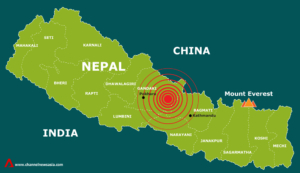
- Center of the earthquake (Source: Channel News Asia)
On 25 April, an earthquake occurred near Kathmandu and Pokhara with a magnitude of 7.9M. Several aftershocks were reported in the region. More than 8,800 people were killed and more than 23,000 were injured. Hundreds of thousands of people were made homeless with entire villages flattened across many districts of the country.
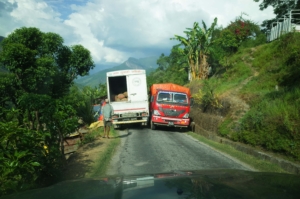
- Supply vehicles on narrow roads
International relief efforts are just scratching the surface compared to the scale and scope of the disaster. Steep mountains and narrow roads have drastically slowed rescue and relief efforts. There are many affected areas where people are still waiting for help from outside. Shortage of supplies and workers as well as caste discrimination has made the situation worse. In their desperation, some villagers have blocked supply vehicles that were on their way to the district headquarters, robbing them in an effort to take and distribute tarpaulins in their own village.

- Tarpaulin to build tent given by UNSCR
-

- People are trying to clean up the rubble of their own homes.
Praise God that different networks of churches around Nepal have responded promptly and been sharing what they have to ease the pain of their fellow countrymen. They have raised funds locally and sent rescue teams to help in remote areas. Our partners are one of those who have mobilized churches in their network to bring relief and rescue very early in the disaster. They provided supplies such as food, water, sleeping mats, tarpaulins to meet the immediate needs of the victims. And above all they have been able to pray with people. In the midst of loss and trauma, people have felt the love of Jesus through his people.
Thanks to the generosity of friends and families from Reconciled World and Disciple Nations Alliance, they have raised the funds to help over 400 families. The goal is to move people from relief stage to stabilizing stage.
Most of the people are still living in temporary shelters made of tarpaulin or whatever material they can find or scavenge, because their houses are either completely collapsed or too dangerous to stay in due to cracks. For those whose houses still stand, they can use it during the day to cook or store food, but they continue to sleep outside at night. The Government is in a long process of making new laws to standardize house rebuilding so no one is allowed to rebuild and repair their home yet. They are only allowed to build temporary shelter until they pass the law. In some villages where they have spare space to build a shelter next to their home, they can reuse current facilities like electricity, water pipes…etc. But, there are villages where almost 100% of houses were destroyed. They have to move to new land and start from the beginning. No house, no water, no electricity—life is much more challenging for these people.

- Temporary shelter made of tarpaulins
It’s been months since the earthquakes, yet everywhere we turn we could see the devastating damage: landslides, rubble, collapsed homes… we kept shaking our head as we saw the scene and imagined the trauma that people have gone through.

- Aftershock hit Sindhupalchok very bad
We visited four areas in Sindhuplachok, Sindhuli, Sankhu districts where the teams had helped and established a relationship. Our desire is not just to give material goods to people and leave but build relationship with people to have a long-term impact even after we finish our relief effort. The Government requires all relief efforts to go through the district headquarters or have special permission from them, but often the relief goods end up in the hands of their favorite people. We wanted to make sure that our help made it to people in real need and was used to actually rebuild houses.
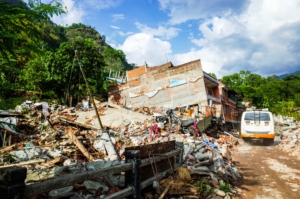
- This rubble still remains months after the quakes.
Local churches played an important role in this process; they initiate and work with community leaders to distribute supplies fairly and to make plans so that everyone works together to achieve the common goal. Even though the resources are from outside, the majority of the work is done by the local community, so the government has not interfered with it. We chose to focus on rebuilding houses because the tarpaulins many people received to build tents have proven too easily damaged against the wind and rain, especially with the approaching monsoon season. Technically, no new homes can be built until the law passes, but semi-permanent structures are allowed. The truth is, most families in the villages we visited will probably live in these tin houses for years to come.
Sinkre

- Church and community leaders are working together in Sinkre to make sure that everyone gets help.
The first place we visited is Sinkre, Sindhupalchok district. 80% of houses were destroyed, more than 1,820 people died, thousands of people were injured, and more than 3,000 people are still missing in the district. It’s one of the worst affected districts. Sinkre village is about 75 kms North East of Kathmandu but it took us more than five hours to get there. It has 70 homes and most of them had collapsed. They had to move to a completely new area. In early May, our partners helped this area with 60 bundles of tin sheets.
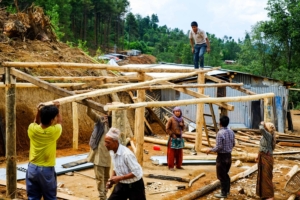
- Five families formed one helping group to build each other’s houses
Thanks to the cooperation of the local church and community leaders, in just five weeks they have managed to build 70 complete houses. They formed helping groups of five families; each family sends one representative to the group to work on someone’s house.
When they finish the first house, they move to the next family until all are complete. If any family cannot send their member, either they will hire another person to replace him or her, or pay 700 Rps ($7) to the group. This way, they were able to finish 70 houses in five weeks. Everyone is so thankful and said that the tin sheets had come at the right time because the monsoon already started. It helped them so much.
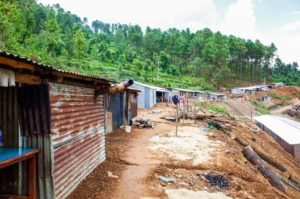
- A new community has formed, not only physically but spiritually. Everyone knew about the love of Jesus and praised the church for what they have done.
They also plan to build 80 more houses because in their old house, often there are at least two or three families. Now they moved to new area, and new house is a lot smaller so each family has to live separately. We are so impressed with this community—the way that they work and support one another—that we promised to provide tin sheets for the last 80 houses. We want this area to be a model community for others.
Thulobandhan
Next, we went to a new area called Thulobandhan, Sindhupalchok district, it’s just 25km from Sinkre. So far, they have not received anything from the local government because they are from a different political party. One time, when they heard that other villages in their ward were receiving some relief, they came to the government office to get help, but everything was all gone. We heard about their situation through a pastor and wanted to understand what was going on. We met with the church and community leader at the local primary school. They cannot use the old building because there are some cracks on it. The government put a big red sticker on the cracked school building saying, “Not safe. Banned,” and yet gave nothing to help repair or rebuild it.

- Cracked School building with ‘banned’ sticker on it
The church had helped to build a few temporary rooms for the school so that children can study.
Most homes are unusable, they have either collapsed or cracked. They are really desperate! When we shared with them about the model in Sinkre, they were so excited, they say they want to do the same and are willing to work together. We are now starting to help rebuild 105 homes and one school here.
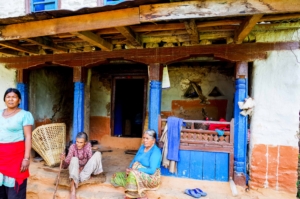
- They use the house during the daytime for cooking but at night they have to sleep outside because they are afraid that it can fall anytime.
Belani
The next area was Belani, Shindhuli district, 135km South East of Kathmandu. There are 76 families – 32 of them are Christian. Like Thulobandhan, people in Belani didn’t receive anything from the government either. They are discriminated against, not because of their political position but because they are low caste, the untouchable (Dalit).
Churches from Sarlahi had helped them with mosquito nets, sleeping mats and tarpaulins but that was all they received. As they were walking with us to our car to say goodbye, they told us the reason why no one wanted to help them except the church was because of their caste. We felt really bad because they tried to invite us to sit down on the dust floor but we refused. We just simply thought that we had sat in the car for 6 hours and it’s nice to stand for a while. We didn’t know that it meant something much more than just sitting down. I don’t think that they would think we look down on them, but it’s a lesson learnt.
When we heard their story and saw their willingness to work hard as they expressed the desire to rebuild their houses before the monsoon season comes, we knew for sure that this is the area we should focus on. 85 families will be provided tin sheets to rebuild their homes in this area.
Bhakari Dada
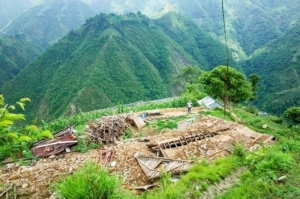
- The whole area is like this. Everything has collapsed.
The last place we visited is Bhakari Dada, a mountainous part of Sankhu, 50kms North of Kathmandu. It’s one of the most severely damaged areas. Even though it’s not far from the capital, landslides have blocked and destroyed roads up here, cutting off the area from the outside world.
When our partners went there in early May for the first time, they had to take a different route, which was 2 hours longer than normal. It’s very dangerous to get there. This area doesn’t have a church, but through a believer in Kathmandu who is originally from this area, our partners were able to bring some help.
We came back to this place in June and had a meeting with community leaders; at that time we delivered a few tin sheets. They still haven’t had any help from the government. They have used some of the tin sheets to rebuild shelters for the most needy people.
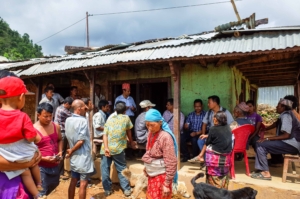
- Meeting with community leaders to share Sinkre’s model. Everyone is excited.
We talked about the idea of the community working together like in Sinkre, and they said, ‘We are ready, all we need is some tin’.
We plan to provide enough tin for 102 families here.
Relief to Taplejung district
Constant rainfall and aftershocks triggered a landslide in Taplejung, a remote area about 310 miles (500km) east of the capital, Kathmandu, on June 11. At least 53 people died and a few dozen are missing. Police say they are finding it difficult to rescue people as rain has caused the water levels to rise in the rivers and streams.
The nearest town is at least five hours away on foot when the weather is good, but getting to the site is taking much longer now. Rain and fog prevented the rescue helicopter from landing.
We sent two of our leaders there to organize relief work. We are not allowed to go to the area because of weather challenges but, by the grace of God, we can register and get permission from the government through a local organization.
We went to India to buy tents because there is nothing left in this area (all went to Kathmandu), and if supplies can be found they are very expensive. We faced a bit of challenge with Indian customs and had to wait there for three hours. In India we were able to buy:
- 102 tents
- 100 foam mattresses
- 100 blankets

- Relief supply for landslide victims in Taplejung
We partnered with a society who had good reputation in the area. Legally, relief supplies are supposed to be deposited in the government’s warehouse, but because of the Christian society they allow the church to keep it and to give it out at the same time with the rice they raised from the local church worth $1,500. They will deliver it to the people later after government assigns the area (there are 700 families affected. We couldn’t go directly because it could cause problems). Because of the weather, even helicopters can’t bring relief to the people, so churches from Christian society will mobilize their members to carry it on foot to the people where they are or meet them half way, and government will provide protection.
We also have a plan to help rebuild houses for this area in the near future.


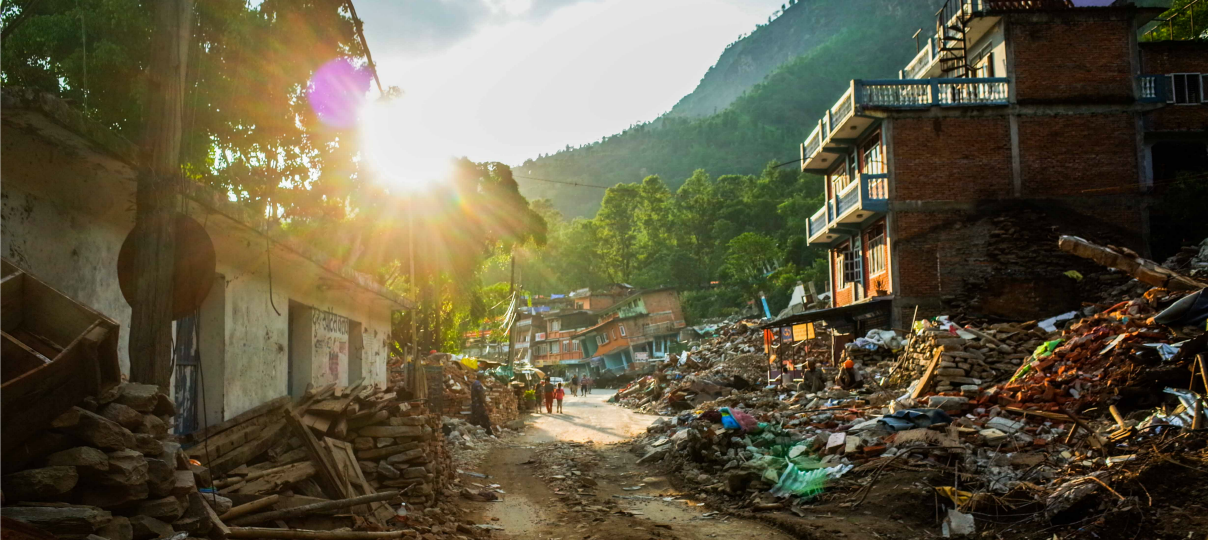
[…] leaders visited Nepal in October to check in on the communities that we’ve been walking with since the earthquake last April. Here are the highlights of the trip. […]